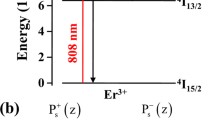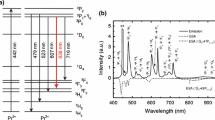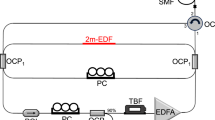Abstract
A novel numerical model of the dual-wavelength fiber ring lasers utilizing gain-equilibrium method is presented by developing the two level, homogeneous Giles model. To obtain the simulation method, the gain equilibrium condition is derived and modified to adapt to the iterative procedure in simulations. This condition is confirmed by both the numerical and experimental results, which indicate that the cavity losses of both wavelength channels play important roles in maintaining stable dual-wavelength emitting. The tolerant loss-bias is 0.05 dB in simulations and 0.4 dB in experiments, respectively. The difference between numerical and experimental results reveals that the inhomogeneous linewidth broadening of EDF contributes mostly to the improved power stability, but the loss vibrations play an important role in this effect.
Similar content being viewed by others
References
E. Desurvire, C. R. Giles, and J. R. Simpson, J. Lightwave Technol. 12, 2095 (1989).
E. Desurvire, J. L. Zyskind, and J. R. Simpson, IEEE Photon. Tech. Lett. 4, 246 (1990).
C. R. Giles and E. Desurvire, J. Lightwave Technol. 2, 271 (1991).
S. K. Kim, M. J. Chu, and J. H. Lee, Opt. Commun. 6, 291 (2001).
A. Bellemare, M. Karásek, M. Rochette, S. LaRochelle, and M. Têtu, J. Lightwave Technol. 6, 825 (2000).
R. Slavik, S. LaRochelle, and M. Karasek, Opt. Commun. 6, 365 (2002).
L. Talaverano, S. Abad, S. Jarabo, and M. López-Amo, J. Lightwave Technol. 4, 553 (2001).
Y. Liu, X. Dong, P. Shum, S. Yuan, G. Kai, and X. Dong, Opt. Express 20, 9293 (2006).
S. W. Harun, R. Parvizi, S. Shahi, and H. Ahmad, Laser Phys. Lett. 11, 813 (2009).
X. Liu and C. Lu, IEEE Photon. Tech. Lett. 12, 2541 (2005).
D. M. Liang, F. X. X., L. Y., H. P. J., Y. Jiang, Z. H. Kang, and J. Y. Gao, Laser Phys. Lett. 1, 57 (2007).
Y. L. J. D. Zhanyuan Liu, Opt. Commun. 7, 27 (2007).
O. Graydon, W. H. Loh, R. I. Laming, and L. Dong, IEEE Photon. Tech. Lett. 1, 63 (1996).
A. Cucinotta, S. Dallargine, S. Selleri, C. Zilioli, and M. Zoboli, Opt. Commun. 141, 21 (1997).
S. Selvakennedy, M. A. Mahdi, M. K. Abdullah, P. Poopalan, and H. Ahmad, Opt. Commun. 170, 247 (1999).
Author information
Authors and Affiliations
Corresponding author
Additional information
Original Text © Astro, Ltd., 2012.
The article is published in the original.
Rights and permissions
About this article
Cite this article
Hu, Z.L., Xu, P. & Jiang, N. Numerical model of dual-wavelength erbium-doped fiber ring laser based on gain-equilibrium method. Laser Phys. 22, 1590–1595 (2012). https://doi.org/10.1134/S1054660X1210009X
Received:
Accepted:
Published:
Issue Date:
DOI: https://doi.org/10.1134/S1054660X1210009X




